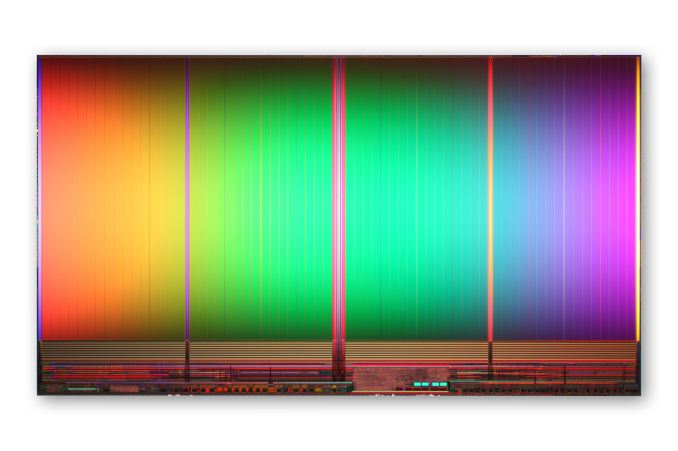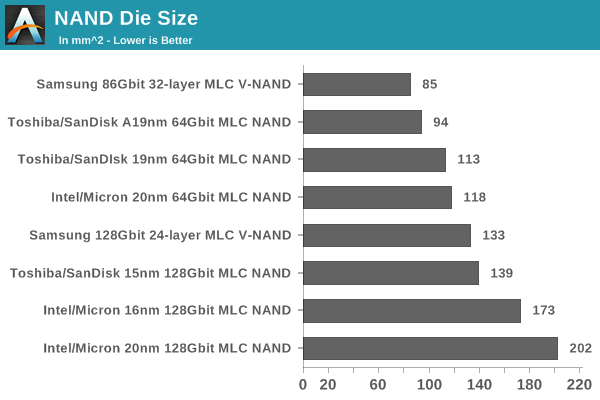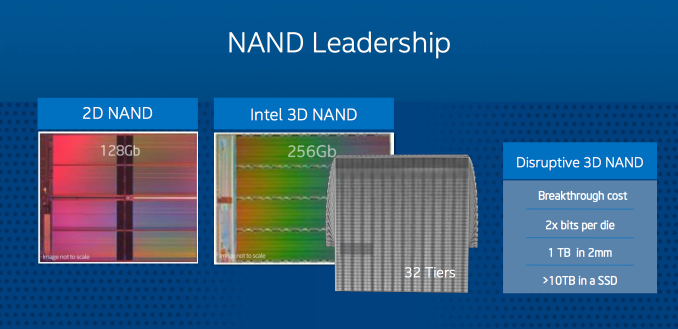Intel's 3D NAND to Ship in H2'15: 256Gbit Die & 32 Layers
by Kristian Vättö on November 25, 2014 5:20 AM EST
Last Thursday in its annual Investor Meeting Intel revealed the first details of its 3D NAND technology and announced that it will begin the shipments of 3D NAND in the second half of 2015. While Intel's investment in 3D NAND hasn't been a secret, the company has been relatively quiet about any specifics and the vital specs such as the number of layers and die capacity have remained unknown. In Thursday's webcast, Rob Crooke, Senior VP and General Manager of Intel's non-volatile memory group, disclosed that Intel's first generation 3D MLC NAND die will be 256Gbit (32GB) in capacity and will consist of 32 layers. The technology also enables a 384Gbit (48GB) TLC (3-bit-per-cell) die as we have learned over the years.
Intel claims that its 3D NAND is the most cost effective on the market and bases this on the fact that its die is 256Gbit whereas Samsung's is only up to 128Gbit at the moment. I'm not sure if I buy Intel's claim because while it's true that a higher capacity die results in higher array efficiency (i.e. peripheral circuitry takes less area), Samsung consciously went from a 24-layer 128Gbit MLC die to a 32-layer 86Gbit MLC die. In other words, Samsung could have upped the die capacity to ~170Gbit by just adding the extra layers, but the company chose to go with a smaller die instead. Smaller capacity dies have advantages in performance (higher parallelism) and applicability because eMMC/microSD devices have very strict die size constraints, so that might be a part of the reason why Samsung's strategy is so different from Intel's and Micron's.

As the graph above shows, Intel's/Micron's NAND dies have historically been larger than the competitors', so the die capacity alone isn't enough to dictate whether Intel's 3D NAND is more cost efficient than Samsung, especially because both have 32 layers. Unlike Samsung, Intel didn't reveal the lithography that is used to manufacture the 3D NAND, but I would say it's safe to assume that the lithography is in the order of 30nm or 40nm because the whole idea of 3D NAND is to move away from multi-patterning to cut costs and with today's technology the smallest pitch of single-patterning is somewhere between 30nm and 40nm. Either way, it will be very interesting to see how Intel's 3D NAND stacks up against Samsung's because there are also some structural differences that affect the production cost as well as performance and endurance, but I'll save the structural analysis for a future article.
Intel said that 3D NAND technology will enable +10TB SSDs in the 'next couple of years', but it wasn't clear whether that is with first generation 3D NAND or some later generation with more layers and higher die capacity. Currently Intel's lineup tops out at 2TB (P3700 & P3600) with a 128Gbit die, so the 256Gbit die alone isn't enough to bring the capacities above 10TB. With effective controller development it should certainly be possible to build a 10TB SSD with a 256Gbit die, although I'm still inclined to believe that Mr. Crooke was referring to second or third generation 3D NAND with his statement.
Similar to Intel's previous NAND efforts, 3D NAND has been jointly developed with Micron and will most likely be manufactured in the co-owned Utah plant as Intel sold its share in other fabs a couple of years ago. Interestingly enough, Mr. Crooke said that they also have the ability to bring 3D NAND production to an Intel fab, although to me that sounded more like a statement of technological possibility rather than a hint of future strategy. I wouldn't rule it out, though, but like Mr. Crooke said in the Q&A, Intel needs to have significant competitive advantage for it to make sense. In the past Intel's NAND technologies have generally been slightly ahead of the rest of the industry, but at least as of now Intel doesn't seem to have any substantial advantage in 3D NAND technology as Samsung is already shipping a 32-layer die and will likely ship a 48-layer die before Intel ships its 32-layer product.
All in all, we'll likely get more crumbs of information as the second half of 2015 gets closer. Given Intel's recent SSD strategy, I expect 3D NAND to first find its way to enterprise-class SSDs, but we'll see soon enough.












58 Comments
View All Comments
Laststop311 - Wednesday, November 26, 2014 - link
And how did they get burnt? The problem is fixed. It no longer exists so they are getting the performance they paid for. Do you not get the problem is fixed now. You act like since there was a problem everyone who bought the evo is still screwed over and all the money was wasted when in reality it's fixed and there is nothing to whine about now.Michael Bay - Saturday, November 29, 2014 - link
Do they pay you for all this verbal barf, at least?asmian - Wednesday, December 17, 2014 - link
If you don't want to read long comments, go troll Twitter instead.xkiller213 - Thursday, December 4, 2014 - link
the vanilla 840 suffers from that problem, and they didn't bother to fix it...http://i.imgur.com/NLAMGmp.png
asmian - Wednesday, December 17, 2014 - link
I'm not "acting" like anything. Read what I wrote instead of complaining about something I didn't write.The original thread poster said he didn't trust anyone EXCEPT Samsung to produce reliable drives. I replied that this was a dubious position because Samsung HAD produced an unreliable drive with a serious problem. Whether they fixed it or not is irrelevant to the false premise that ONLY Samsung can be trusted to make reliable drives.
Laststop311 - Wednesday, November 26, 2014 - link
and yes admitting the problem doesnt excuse the original failing but promptly fixing it does.eek2121 - Thursday, November 27, 2014 - link
Debacle? How long have you been working on a technical level with technology? Samsung has had amazing tech support/response times compared to the rest of the industry. I still have a hard drive made by western digital 10 years ago that has a firmware bug (that causes data corruption) and has never received an update. Samsung SSDs are probably the fastest and most reliable out there. We use them for our desktops and our servers. I can forgive a company for an unforseen bug. I cannot forgive a company that refuses to fix said bugs.Pork@III - Tuesday, November 25, 2014 - link
Boys. Boys! Silence! :D Now I go back from 2025 and stick my super-duper faster USSB 16.0 with 20PB volume and speed of light read/write. This stick have trademark "DJ波波" who's makers also of doner of every corner. Intel turnip to eat and now must to begin much more R&D work to do, for not to be overtaken by someone worked in your garage Thai.sonicmerlin - Tuesday, November 25, 2014 - link
"it's safe to assume that the lithography is in the order of 30nm or 40nm because the whole idea of 3D NAND is to move away from multi-patterning to cut costs and with today's technology the smallest pitch of single-patterning is somewhere between 30nm and 40nm"I've been frustrated wondering why Samsung didn't aim for 32 layers on a 2X node. They could completely disrupt the current SSD market and bring per GB costs to be on par to HDDs.
I've been waiting eagerly for a competitor to bottom out the market. The idea of a 1 TB flash drive as the minimum on a future iPad or really any mobile device is extremely exciting.
Laststop311 - Wednesday, November 26, 2014 - link
did u not read? it is cheaper to be on 30 to 40 due to single patterning of the lithography. It's cheaper to manufacture at that node. if 20nm was cheaper for them to make it they would charge the same price and pocket and even bigger profit margin. They aren't stupid every company wants to maximize thier profits.